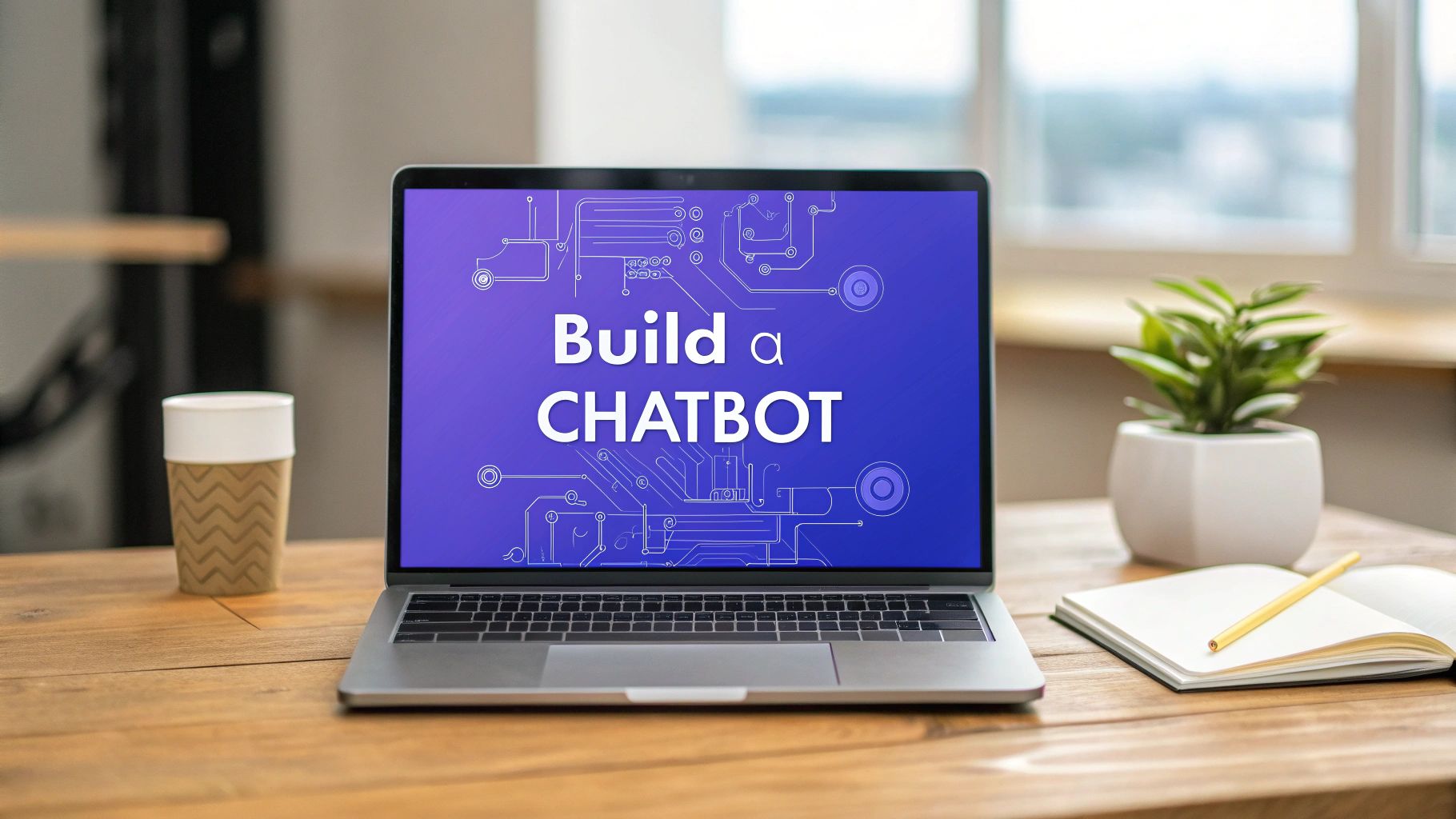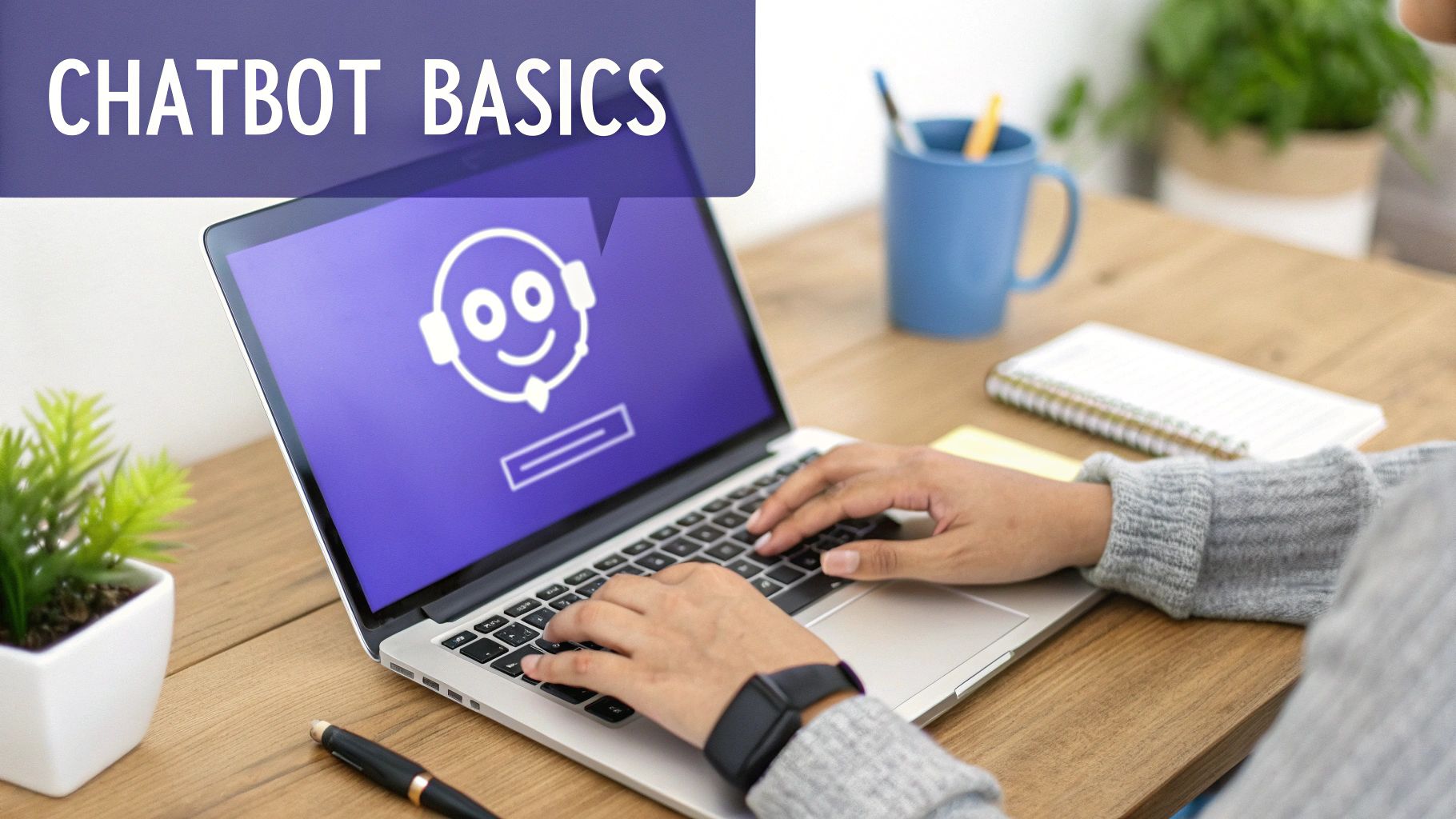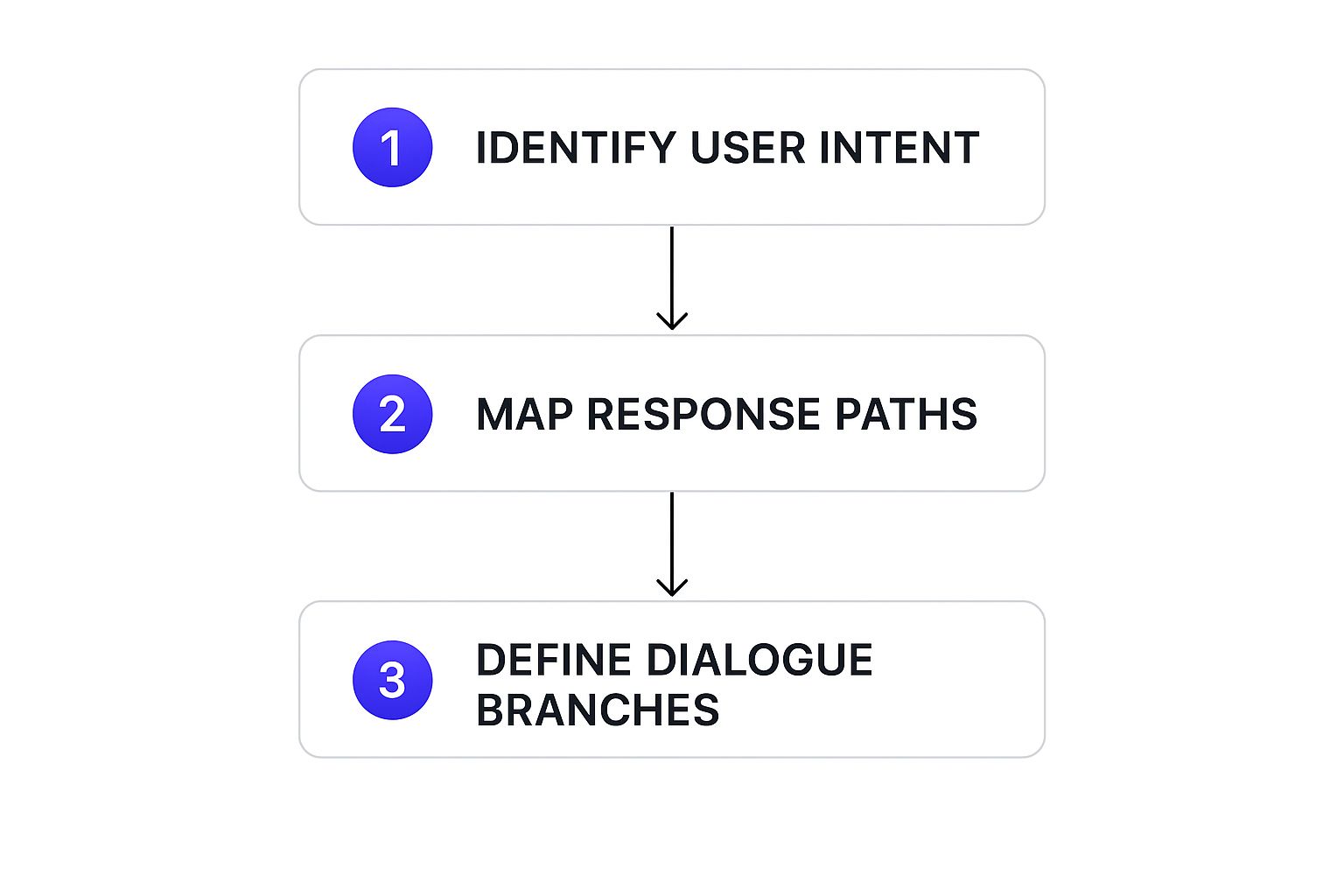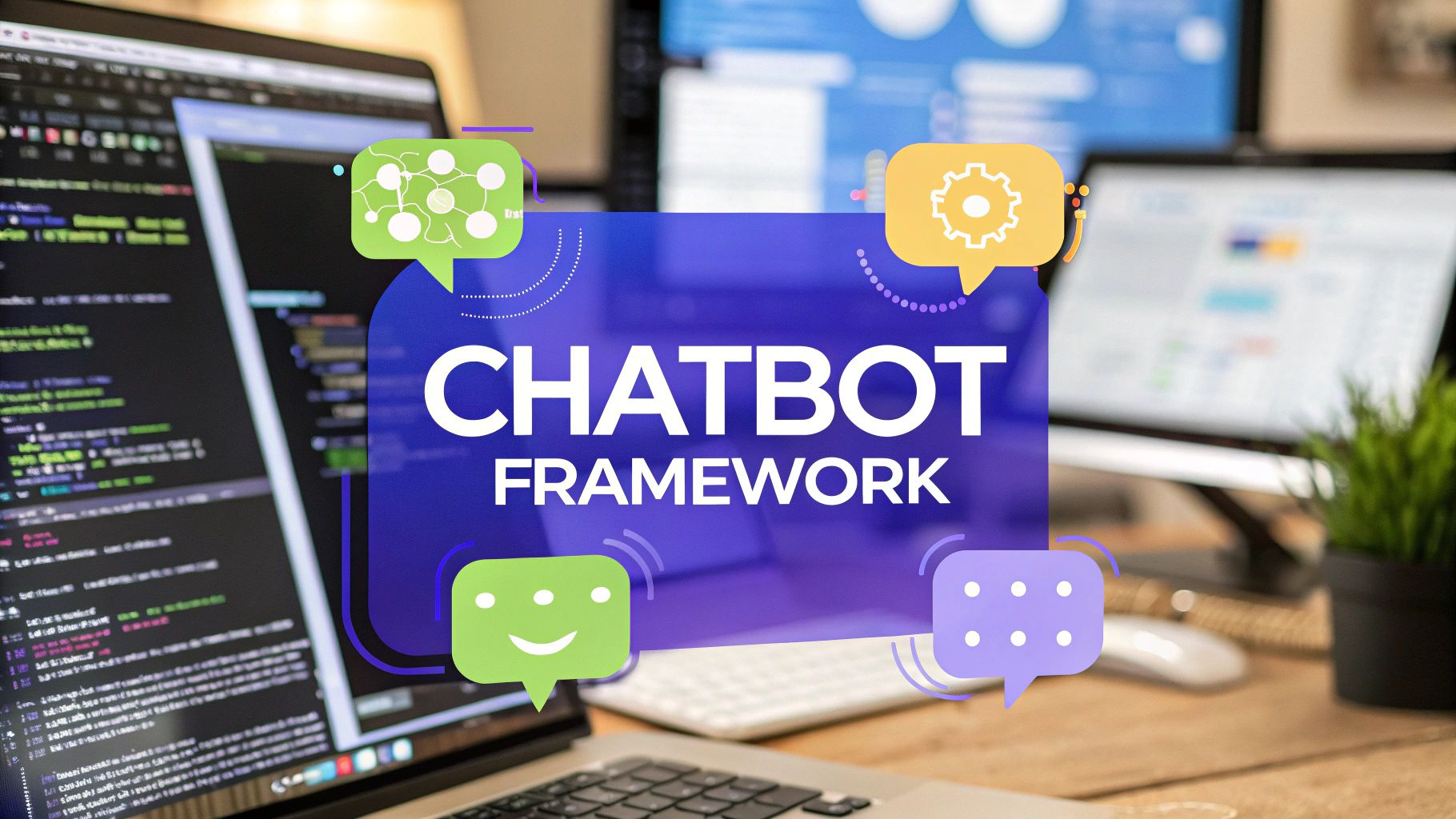Build a Chatbot: A Simple Guide to Create Your AI Bot
Learn how to build a chatbot for your business with our practical guide. Step-by-step tips to create, train, and deploy your AI chatbot successfully.

Before you start building a chatbot, it helps to see the big change they represent. They are not just another support tool; they are a new way for businesses to talk with their customers, moving from one-way messages to real-time, two-way conversations. This guide will walk you through building one with Chatiant.
Why a Custom Chatbot Is a Game-Changer

Most people who decide to build a chatbot start with a simple goal, like handling common questions. But their true power goes beyond that. When designed right, a bot becomes a core part of your business strategy, working 24/7 to push your goals forward.
A custom chatbot is a proactive engagement machine. It can qualify leads on the spot, guide users to the perfect product, and gather valuable feedback without missing a beat. That kind of instant interaction is exactly what modern customers expect.
The Business Case for Chatbots
Businesses that use chatbots effectively see real, tangible benefits that stretch far beyond basic automation. The big wins usually fall into a few key areas:
- Improved Efficiency: Bots handle the high volume of repetitive questions instantly. This frees up your human agents to tackle the complicated, high-touch issues where they're needed most.
- Reduced Operational Costs: By automating front-line support and lead qualification, you can seriously cut down on expenses tied to staffing and training.
- Better Customer Experience: Offering 24/7 support means customers get help the moment they need it, day or night. That is a massive driver for satisfaction and loyalty.
- Increased Lead Generation: A chatbot can greet every website visitor, ask the right qualifying questions, and even book meetings, turning passive traffic into active sales opportunities.
The demand for these benefits is fueling some pretty wild market growth. The global chatbot market was valued at $2.47 billion in 2021, but it skyrocketed to an estimated $15.57 billion by 2025. Projections show it hitting an incredible $46.64 billion by 2029. You can read more about the chatbot market's explosive growth to see what's behind the trend.
A chatbot serves as a digital front door for your business. It’s often the first point of contact for a potential customer, making its design and intelligence important for making a good first impression.
Understanding this "why" is the most important first step. It frames the whole process not as a technical chore, but as a strategic decision. When you build a chatbot with clear business goals from the start, you are creating an asset that delivers measurable returns.
Creating a Blueprint for Your Chatbot

Before you write a single line of dialogue or touch any AI settings, a successful chatbot starts with a solid plan. I've seen it happen too many times: teams get excited and jump straight into the build, only to end up with a bot that doesn't really do anything useful. It is like trying to build a house without a blueprint.
The very first step to build a chatbot that actually works is to define its core purpose.
What is the one main job you want this bot to do? Do not try to make it a jack-of-all-trades right out of the gate. A focused bot is an effective bot. Common goals I see are generating sales leads, offering instant customer support, or helping users find their way around a complex website.
A well-defined primary goal acts as your North Star. Every feature, conversation flow, and personality trait you choose should directly support this main objective. This keeps you from getting distracted by shiny features that don't add real value.
For instance, a chatbot built for lead generation should be asking qualifying questions and trying to book meetings. A support bot, on the other hand, will focus on pulling answers from a knowledge base to resolve user issues. Defining this primary role sharpens your focus and prevents scope creep.
Pinpointing the Problem It Solves
Once you have a primary goal, get specific. What problem is this chatbot really solving? It's helpful to think about this from two angles: your user's and your business's.
For your users, the problem might be waiting too long for a support agent or struggling to find pricing information. For your business, it could be a high volume of repetitive questions tying up your team or a leaky sales funnel on your contact page. A great chatbot addresses pain points on both sides of the equation.
As you start to formalize your plan, a good step-by-step guide on how to build an AI chatbot can be incredibly helpful. It provides a structure to move from these high-level goals into the nitty-gritty of execution.
Mapping the User Journey and Setting KPIs
With your goals and problems defined, you can start sketching out potential conversations. Put yourself in your user's shoes. What question will they likely start with? What follow-up questions will they have? This is the foundation of your conversation flow.
At the same time, you need to decide how you'll measure success. Setting Key Performance Indicators (KPIs) from the start is the only way to know if your chatbot is actually working. Otherwise, you're just guessing.
Here is a simple framework I use to connect business goals directly to measurable outcomes.
Chatbot Goal-Setting Framework
Using a structured approach like this makes sure you build a chatbot that is not just a gimmick, but a purposeful tool that delivers real, measurable value to your business.
Building Your First Bot with Chatiant
Alright, with your blueprint ready, it's time to roll up your sleeves and move from planning to practice. This is where you get hands-on and actually build a chatbot using Chatiant’s platform. The whole process is designed to be surprisingly straightforward, even if this is your first time working with AI tools.
First things first, you'll need to set up your account and create a new project. This is your gateway into the Chatiant dashboard, which acts as the command center for your entire operation. Think of it as the workshop where you'll assemble and fine-tune your bot.
Navigating the Chatiant Dashboard
Once you're in, take a moment to get your bearings. The dashboard is laid out to make finding what you need simple, with clear options for creating new bots, managing existing ones, and checking in on analytics later on.
The real heart of a smart chatbot is its knowledge. That is why the most important place to start is the Knowledge Base section. This is where you will feed your bot the raw material it needs to learn and develop its conversational skills.
Here is a look at the initial project setup screen.

As you can see, the interface is clean and gets you started fast. You can name your project and get right to the data upload process.
Supplying Your Bot with Knowledge
A chatbot is only as good as the information you give it. Chatiant makes this part incredibly easy by supporting a few different data sources. You have options:
- Website URLs: Just paste in links to your key website pages like FAQs, product descriptions, or support articles. Chatiant will automatically crawl and process the content for you.
- Document Uploads: If your knowledge is locked away in PDFs or Word documents, you can upload them directly. This is perfect for internal documentation, spec sheets, or detailed guides.
- Raw Text: For quick additions or specific bits of information, you can simply copy and paste text right into the editor.
Once you upload this information, Chatiant’s AI gets to work. It reads, understands, and organizes the data, creating a foundational "brain" for your new chatbot. This is what allows the bot to start answering questions accurately and contextually almost immediately.
For a deeper look into this initial stage, our complete guide on how to build a chatbot breaks down the whole process with more tips for a successful build.
And if you are curious about what is happening under the hood, this guide on how to build an AI agent with n8n and OpenAI gives a great technical look at how intelligent automation is constructed. While Chatiant handles all that for you, it can be insightful to see the underlying principles.
With your knowledge base uploaded, your bot now has its foundation. You're ready for the next phase: training and customization.
Time to Train and Customize Your Chatbot

Alright, your chatbot is built and its knowledge base is loaded. But this is where the real work begins, the part that turns a generic tool into a smart, on-brand assistant.
A brand-new bot is functional, sure. But it is the ongoing training and customization that will shape its personality, sharpen its intelligence, and make it genuinely helpful with every user interaction.
Refine Responses and Grow Its Knowledge
So, where do you start? Your best source of truth is right there in your Chatiant dashboard: the conversation logs. This is where you can see exactly what users are asking and how your bot is actually responding.
I can't stress this enough: regularly reviewing these logs is the single best way to spot where your bot is getting stuck or giving clunky answers. You might notice it misunderstands a common question or completely lacks information on a specific topic.
When you find a conversation that went sideways, Chatiant lets you jump in and manually correct the answer. You can edit a response for better clarity, tweak its tone to fit your brand voice, or add important details that were missing. This feedback loop is vital. Every correction you make helps the underlying AI learn and improve its future performance.
But you're not just limited to fixing existing answers. You can actively teach your bot new things. When logs reveal questions your knowledge base doesn't cover, you can add new question-and-answer pairs on the fly. For instance, if customers suddenly start asking about a new product feature before your website is even updated, you can teach the bot how to handle that question immediately.
Once you build a chatbot, the very next step is training it with relevant information. For more tips on this, check out this excellent guide on how to train a chatbot with your own data.
This continuous cycle of reviewing, refining, and teaching is what makes your bot smarter over time. For a deeper look, our guide on https://www.chatiant.com/blog/how-to-train-a-chatbot offers more advanced techniques.
Customize Your Chatbot’s Look and Feel
Beyond its brain, your chatbot’s appearance and behavior play a huge role in the user experience. You want it to feel like a natural extension of your website, not some clunky widget that was just tacked on.
In Chatiant, you have a ton of control over this:
- Visual Branding: Change the chatbot's colors, logo, and avatar to perfectly match your company's branding.
- Automated Greetings: Set up proactive welcome messages that greet visitors and suggest common starting points.
- Behavioral Rules: Decide how the chatbot appears. Should it pop up after a few seconds, or should it wait for the user to click first?
These settings are what transform your bot into a true brand representative. A well-designed bot that reflects your brand and provides a consistent, helpful experience becomes an integral part of your customer journey.
After all the hard work planning and training, the big moment is finally here. It is time for your chatbot to go live and start talking to real users on your website.
Getting it there is surprisingly simple, especially with a platform like Chatiant. Deploying your bot usually just means embedding a small widget on your site. This is as straightforward as copying a single line of code Chatiant gives you and pasting it into your website’s HTML. It's a quick task whether you're on WordPress, Webflow, or another platform, and it brings your bot to life instantly.
Once that snippet is in place, your chatbot will pop up on your site, ready to greet visitors. But launching it is not the finish line, it is the starting line for the next, equally important phase: continuous improvement.
Tracking Performance with Analytics
Going live opens up a direct channel to your users, and with it comes a flood of incredibly valuable data. Your job now shifts from building the bot to monitoring and optimizing it. Chatiant includes an analytics dashboard designed to give you a clear view of how your chatbot is performing out in the wild.
This dashboard is your window into what users are actually doing. You can track key metrics that tell the real story of your bot's effectiveness. Paying attention to these numbers is how you turn a functional chatbot into a high-performing one.
Think of your chatbot's launch as its first day on the job. It has all the training, but now it needs real-world experience. The analytics dashboard is your way of conducting its performance review, giving you the insights needed for it to grow and get better at its role.
Key Metrics to Monitor in Chatiant
To make sense of all the data, you really only need to focus on a few core metrics that tie back to your original goals. These numbers will guide every tweak and optimization you make.
- User Engagement Rate: This tells you how many of your website visitors are actually interacting with the chatbot. If this number is low, you might need to make your welcome message more inviting or adjust how the bot appears on the page.
- Most Common Questions: This report is a goldmine. It highlights what your users are most interested in, showing you exactly where you might have gaps in your knowledge base or uncovering new customer pain points you didn't even know existed.
- Resolution Rate: This measures how often the chatbot successfully answers a question without needing to pass the conversation to a human. A high resolution rate is a fantastic sign of a well-trained, effective bot.
- Conversation Duration: How long do interactions last? Short, successful conversations are great for simple FAQs. Longer ones might point to deeper engagement or, on the flip side, user confusion. The context here is everything.
By checking these metrics regularly, you create a data-driven feedback loop. You see what is working, what is not, and where to focus your energy. This ongoing process of monitoring and refining is what makes sure your chatbot continues to deliver real value long after its launch day.
Common Questions About Building a Chatbot
Even with a no-code platform like Chatiant, jumping into your first chatbot project can feel like a big step. It's only natural to have a few questions. Let's walk through some of the most common ones we hear from people who are ready to build a chatbot.
How Much Does It Cost?
This is usually the first question on everyone's mind. If you were hiring developers to build a chatbot from scratch, you could easily be looking at an investment of thousands of dollars.
But using a platform like Chatiant completely changes the game. Instead of a massive upfront cost, you are looking at a monthly subscription that is based on your usage. These plans are designed to be accessible, often starting at a price that works even for small businesses, and they scale with you as your needs grow.
Do I Need Coding Skills?
Absolutely not. This is one of the biggest myths out there. No-code platforms are built from the ground up for non-technical users. Seriously, if you can use a computer and upload a document, you have all the skills you need.
The whole process, from creating the bot and feeding it your knowledge base to customizing how it looks, is handled through a simple, visual interface. No command lines, no confusing syntax.
You're not expected to write code; you're expected to provide knowledge. The platform handles all the complex technical work behind the scenes, so you can focus on making your bot smart and helpful.
How Long Does It Take to Build a Chatbot?
You'll probably be surprised by how fast this part is. With a platform, you can get a basic, working chatbot online in just a few hours. The initial setup is straightforward: create an account, point the bot to your website URLs or upload your documents, and let the AI do its thing.
Of course, the more you want to fine-tune its personality and test its responses, the more time you'll invest. But getting a fully trained and tested bot live on your website is something you can realistically achieve in less than a week.
How Do I Make It Better After Launch?
Here is a secret: a chatbot is never really "finished." The best bots are the ones that are constantly learning and improving, and that is where the real magic happens. The key to long-term success is to regularly check its conversation logs. This gives you a direct window into what your users are actually asking.
From there, it becomes a simple cycle of refinement:
- Update the knowledge base to fill in answers for new or missed questions.
- Tweak existing answers to make them clearer or more helpful.
- Spot information gaps that your bot needs to learn about.
This feedback loop is what keeps your chatbot sharp, accurate, and genuinely valuable to your customers. If you want to look further into this ongoing process, we highly recommend reviewing these chatbot best practices.
Ready to create a smart assistant that delights customers and saves you time? With Chatiant, you can build a chatbot trained on your own data in minutes, not months. Start your free trial today and see how easy it can be.


